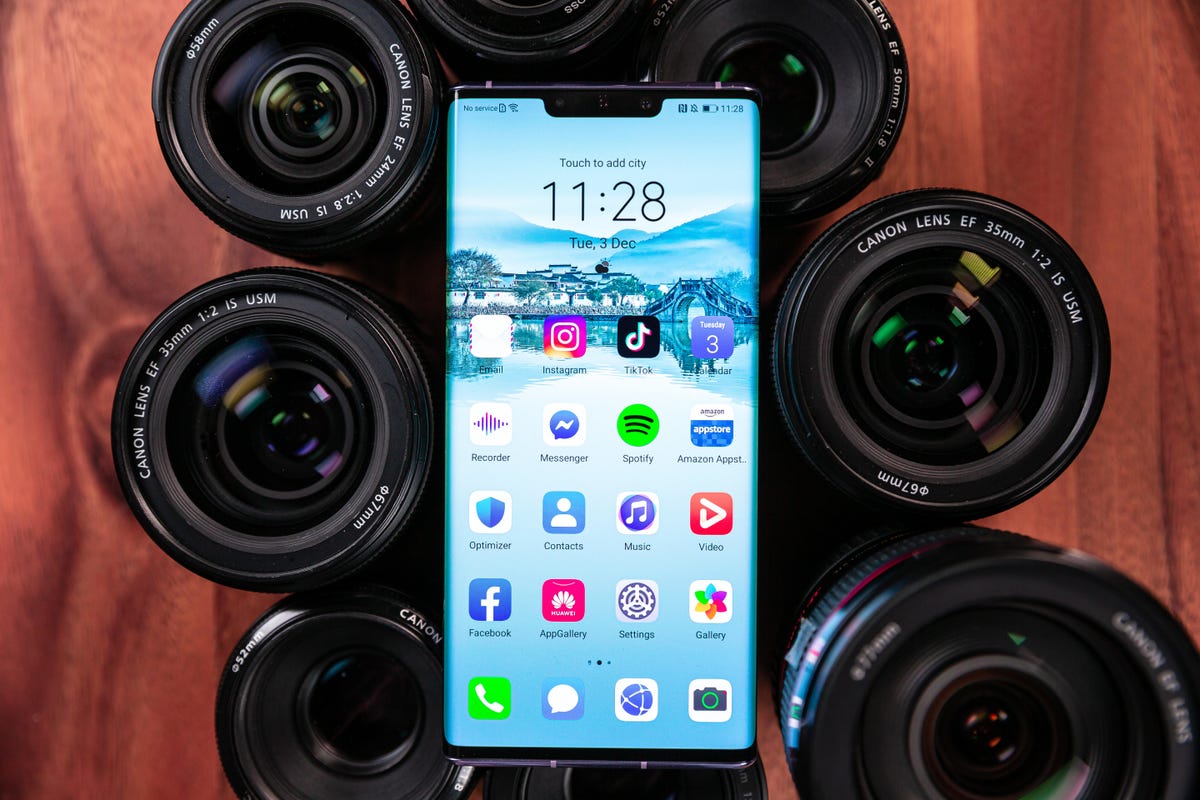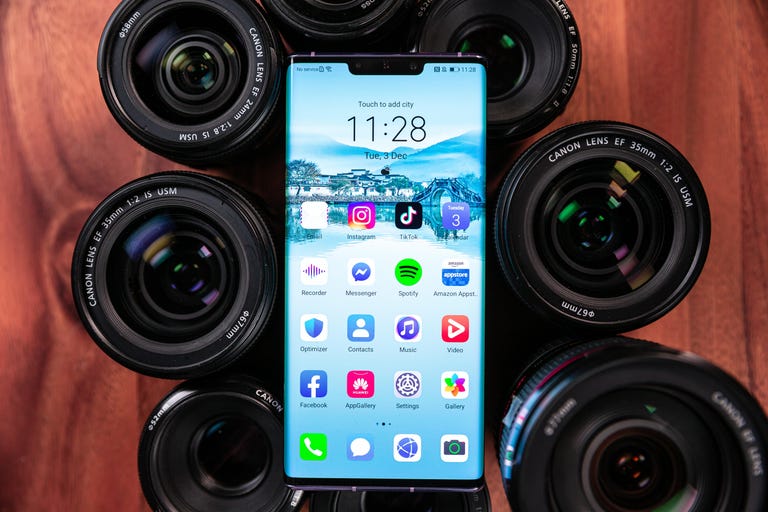 Why You Can Trust CNET
Why You Can Trust CNET Huawei Mate 30 Pro review: Sublime camera, disastrous software
The slick Huawei Mate 30 Pro is a powerhouse phone with a stellar camera. It's also useless outside of China.
The Huawei Mate 30 Pro.
Update, March 26: The Huawei P40, P40 Pro and the P40 Pro Plus have now officially been launched. Read our first take here.
Like
- Quad-camera setup takes outstanding photos and astonishing slow-motion video
- Original, slick and distinct design
- Battery life is super impressive
Don't like
- An Android phone without full Google support is a disaster
- Waterfall display is luxurious, but the loss of a volume button is awkward
Huawei started 2019 strong with the excellent P30 Pro phone, but things went downhill from there. Due to concerns that its equipment could be used to spy on the US and other companies, the Chinese tech giant has been banned from using technology from US companies. As a result, it can't license Google Mobile Services. The Mate 30 Pro, its latest flagship, has no Google Play Store, and no apps like Google Maps,
Gmail
and YouTube.
It has the striking appearance of a futuristic slab of aluminum and glass, but I knew I was in for a rough ride just moments after booting up the Mate 30 Pro. Entering the AppGallery, Huawei's version of the Google Play Store, I was encouraged to download some of its most popular apps: Weibo, WeChat and the China Drama Channel. It quickly became clear that Huawei doesn't have much to offer its non-Chinese customers.
One question has enshrouded the Mate 30 Pro since Huawei's tech ban: Can Huawei, a huge, powerful company with deep resources, find a way to neutralize the loss of Google?
The answer, unfortunately, is no.
The Mate 30 Pro is an exceptional piece of hardware. Its quad-camera setup shoots outstanding photos (sometimes better than the iPhone 11 Pro) a dazzling 6.53-inch waterfall display is the centerpiece of an inspired design, and its 4,500-mAh battery goes and goes and goes. But the fiasco that is Android without full Google support makes it impossible to recommend.
Even more galling is the Mate 30 Pro's price. The phone starts at AU$1,599 in Australia, which converts to $1,100 or £830. (No availability has been announced for either the US or UK.) Yes, it's a premium phone and premium parts ain't cheap. But as a proposition to you, the buyer, that much money for a partially functioning phone is preposterous.
Huawei tries Android without all of Google
Since Android 10 itself is open-source, the Mate 30 Pro still runs Google's most recent operating system fine. But since Google Mobile Services requires a license, Huawei has no access to the Google Play Store or any of Google's apps.
Instead, you'll use Huawei's AppGallery, which the company says has over 45,000 apps. That sounds like a lot, but I could count the useful apps in the AppGallery on one hand.
There's no Facebook, Instagram, WhatsApp, Netflix, Disney Plus or Reddit. You won't find Google apps, like Gmail, Maps or YouTube. (You can log into Gmail through Huawei's native email app, though.) Even if you do install Google apps by downloading their APKs -- the Android equivalent of Windows' .exe files -- they won't work without authentication from Google Mobile Services. Uber doesn't work either, since the ride-sharing app runs Google Maps. Losing Google's suite of apps is devastating; losing almost every useful app in the Google Play Store is debilitating.
Huawei's AppGallery has over 45,000 apps. You'll find few of them useful.
Of all the apps I download onto every new phone, only one was available: Spotify. When I tried to find Spotify in the AppGallery a week later, however, it appeared to have been pulled. TikTok (which is owned by Chinese company Bytedance) was available at first, then disappeared and then appeared again.
To get around the software obstructions I downloaded APKs from assorted websites. It was a dodgy process, and worked inconsistently. Some apps ran fine, others crashed after a few moments and others still didn't work at all.
It was a total mess.
Huawei Mate 30 Pro's camera credentials
If Huawei phones have been known for one thing, it's cameras. Huawei beat competitors to the punch with dual-lens cameras (P9), a dedicated Night Mode (P20 Pro) and 5x optical zoom (P30 Pro). Photography is undoubtedly the Mate 30 Pro's greatest strength.
The phone has a fantastic quad-camera setup. The main shooter has 40 megapixels. Then there's an 8-megapixel telephoto lens, which has a 3x optical zoom and 30x digital zoom; a 40-megapixel ultrawide-angle lens; and there's a 3D "time-of-flight" sensor that helps with depth perception.
The Mate 30 Pro has less zoom capability than Huawei's current flagship the P30 Pro , which has 5x optical and 50x digital. But it has a bigger, better ultrawide-angle sensor over the P30 Pro. This is a worthwhile trade, because I find ultrawide-angle capability much more useful than better zoom functionality.
Some Portrait shots give the subject brushed, lightened skin.
Others work better.
The Mate 30 Pro's quad-camera setup generally captures crisp, vibrant shots.
See that fountain all the way in the back?
Here it is, shot with 30x zoom.
Photography isn't perfect. Thanks to heavy software processing, skin can look artificially brushed in Portrait shots. This processing also makes Night Mode superfluous: Low-light shots capture an impressive amount of light, and toggling on Night Mode often results in overkill. I didn't have the option to shoot a dark photo even when I wanted to because the scene is brightened with software by default.
But despite these issues, the Mate 30 Pro has one of the best camera setups on any Android phone. Photos generally look spectacular, with rich color and crisp detail.
And Huawei packed in another innovative trick, but this time for the video camera. The Mate 30 Pro features stupefying slow-motion capabilities. There are four options: 4x, 8x, 32x, 64x and an astonishing 256x. That 256x option uses AI software to slow things down to 7,680 frames per second.
Slow-motion cameras need more light, so you'll need a reasonably bright environment to take advantage of ultra-slow-mo. And since 256x slow motion makes 25 seconds out of one-tenth of a second, you'll need good timing to shoot the split second you want in slow-mo. But I found the feature super fun to play around with. It makes something as little as a water splash look spectacular.
256x slow mo on Huawei Mate 30 Pro pic.twitter.com/7TxuJAmVzE
— Daniel Van Boom (@dvanboom) December 11, 2019
Good parts, bad phone
In regards to hardware, the Mate 30 Pro is luxurious in every aspect.
Its 6.53-inch, 2,400x1,176x-pixel screen is beautiful, bright and crisp. Its OLED screen is a waterfall display, meaning it wraps around the side of the phone all the way to the aluminum back. Videos and browsing were a joy, and the glass body felt more luxe to hold than aluminum. The downside is that there are no volume buttons, so I had to tap the side of the display to activate an on-screen volume slider instead. This generally works OK, but makes quick volume changes more cumbersome than they need be.
Powered by Huawei's own Kirin 990 processor and 8GB of RAM, the Android heavyweight felt silky smooth to use. But where the Mate 30 Pro really shines is battery life. Running it through CNET's battery test -- turning the phone on Airplane mode and looping an HD video -- it lasted 24 hours, 12 minutes. That's crazy.
The best phone you shouldn't buy.
I wish I could say that the Kirin 990 CPU also scored well on Geekbench 5, a benchmark we run to test a processor's efficiency. Saying it performed well would be a safe bet but, after downloading the APK for Geekbench 5 from four different sites, the app never worked. I could try searching for more Geekbench APKs, but I think this anecdote is an apt encapsulation of the Huawei Mate 30 Pro.
It's a beautiful device with powerful parts and a sublime camera. But its software situation is a disaster. Don't buy this phone.
Originally published Dec. 17.
Update, Dec. 28: Adds video review, comparison to iPhone 11 Pro camera.
Huawei Mate 30 Pro
| Huawei Mate 30 Pro | Google Pixel 4 XL | Samsung Galaxy Note 10 | OnePlus 7T | iPhone 11 Pro | |
|---|---|---|---|---|---|
| Display size, resolution | 6.53-inch OLED | 6.3-inch OLED | 6.3-inch AMOLED; 2,280x1,080 pixels | 6.55-inch AMOLED; 2,400x1,080-pixels | 5.8-inch OLED Super Retina XDR; 2,436x1,125 pixels |
| Pixel density | 409ppi | 537ppi | 401ppi | 402ppi | 458ppi |
| Dimensions (Inches) | 6.22 x 2.88 x 0.35 in | 2.9x6.3x0.3 in | 5.94x2.83x0.31 in | 6.34x2.93x0.32 in | 5.67x2.81x0.32 in |
| Dimensions (Millimeters) | 158.1x73.1x8.8 mm | 75.1x160.4x8.2 mm | 151x71.8x7.9 mm | 160.94x74.44x8.13 mm | 144x71.4x8.1 mm |
| Weight (Ounces, Grams) | 6.98 oz; 198g | 6.8 oz; 193g | 5.93 oz; 168g | 6.70 oz; 190g | 6.63 oz; 188g |
| Mobile software | Android 10 with EMUI | Android 10 | Android 9 Pie | Android 10 with OxygenOS | iOS 13 |
| Camera | 40 megapixel (standard), 8 megapixel (telephoto), 40 megapixel (ultrawide-angle), 3D ToF sensor | 12.2-megapixel (standard), 16-megapixel (telephoto) | 12-megapixel (wide-angle), 16-megapixel (ultra-wide angle), 12-megapixel (telephoto) | 48-megapixel (standard), 12-megapixel (telephoto), 16-megapixel (ultra wide-angle) | 12-megapixel (wide), 12-megapixel (ultra-wide), 12-megapixel (telephoto) |
| Front-facing camera | 32 megapixel, 3D ToF sensor | 8-megapixel | 10-megapixel | 16-megapixel | 12-megapixel |
| Video capture | 4K | 4K | 4K | 4K | 4K |
| Processor | Kirin 990 | 2.84GHz octa-core Qualcomm Snapdragon 855 | Qualcomm Snapdragon 855 processor, or Samsung Exynos 9825 | 2.96GHz octa-core Qualcomm Snapdragon 855+ | Apple A13 Bionic |
| Storage | 128GB, 256GB | 64GB, 128GB | 256GB | 128GB | 64GB, 256GB, 512GB |
| RAM | 8GB | 6GB | 8GB | 8GB | Not disclosed |
| Expandable storage | Up to 256GB | No | No | No | No |
| Battery | 4,500-mAh | 3,700-mAh | 3,500-mAh | 3,800-mAh | Not disclosed, but Apple claims it will last 4 hours longer than iPhone XS |
| Fingerprint sensor | In-screen | No | In-screen | In-screen | No |
| Connector | USB-C | USB-C | USB-C | USB-C | Lightning |
| Headphone jack | No | No | No | No | No |
| Special features | Up to 256x slow motion; wireless charging; reverse charging; IP68 resistance; dual-SIM; waterfall display | Soli motion sensing and touchless gestures; 90Hz display; water resistant (IP68); dual-SIM capabilities (nano-SIM and e-SIM); wireless charging | S Pen stylus; Wireless PowerShare; hole punch screen notch; water resistant (IP68) | 90Hz display; dual-SIM; Warp Charge 30T | Water resistant (IP68); dual-SIM capabilities (nano-SIM and e-SIM); wireless charging |
| Price off-contract (USD) | Converted: About $1,100 | $899 (64GB), $999 (128GB) | $949 | $599 | $999 (64GB), $1,149 (256GB), $1,349 (512GB) |
| Price (GBP) | Converted: About £830 | £829 (64GB), £929 (128GB) | £899 | Converted: About £485 | £1,049 (64GB), £1,199 (256GB), £1,399 (512GB) |
| Price (AUD) | AU$1,599 | AU$1,279 (64GB), AU$1,429 (128GB) | AU$1,499 | Converted: About AU$890 | AU$1,749 (64GB), AU$1,999 (256GB), AU$2,349 (512GB) |



